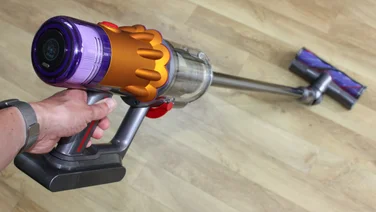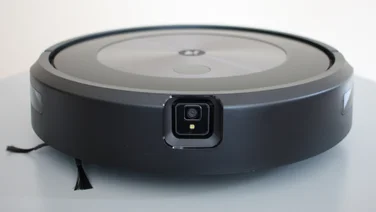To help us provide you with free impartial advice, we may earn a commission if you buy through links on our site. Learn more

















- Self-emptying
- Affordable
- Convenient
- Average cleaning
- No soft roller
- Lacks anti-tangle tech
The Ultenic FS1 is here to rescue us from the messy cloud of dust that still accompanies the emptying process of the vast majority of cordless stick vacuums. This model empties in the same way as its rivals, by opening a flap in the base of the collection bin to let the debris fall out. However, it comes with a self-emptying base station, which has its own vacuum built in. By attaching the FS1 to its base and holding down the button on the top, the station’s vacuum is engaged, the collection bin door is opened, and all the dirt is sucked out and into a convenient bag hidden away in the station.
We’ve seen a similar system before in the Samsung Bespoke Jet, but this rival model costs half the price. It’s worth noting that the Samsung also comes with a mopping function and a greater number of features. However, if emptying your cordless vacuum cleaner is the task you dislike the most, there could be enough in the Ultenic FS1 to win you over.
Ultenic FS1 review: What do you get for the money?
The actual vacuum cleaner part of the Ultenic FS1 follows a standard three-part design, with a floor head at the base that connects to an extension wand and the main vacuum engine at the top. The three parts click together easily, with the most unusual element being the extension wand, which is in two parts and extends telescopically to reveal its full length.
The floor head uses a single brush roller, which is lined with two types of brushes: a short, stiff one for carpets and a longer, softer brush for dusting hard floors. This means the one floor head should handle both floor types, so there’s no need to switch heads between surfaces.
At the other end the vacuum unit sits on top of a 660ml collection bin, which is about average size for this kind of device. It’s located to the side of the connection to the extension wand, so vacuumed debris has to make a 90-degree turn to pass through into the bin; however, I didn’t encounter any blockages during testing.
Fully assembled, the FS1 measures 251 x 210 x 1,180mm (WDH) and weighs 3.09kg. Most of the weight (1.99kg) is in the upper unit, while the floor head comes in at only 749g. There are two attachments in the box, a small crevice tool and a dusting brush, either of which can be clipped straight onto the vacuum or used in conjunction with the extension wand.

















The emptying and charging stand takes up the bulk of the box. This needs plugging into a wall socket, and stands at 270 x 284 x 625mm (WDH). The extension wand has to be closed up for the vacuum unit to fit into place, but it then sits neatly on the top. Stowed away in this way, the combination of the stand and the vacuum measures 940mm tall.
There are a few spare consumables in the box – two extra 3l bags for the emptying station and a replacement filter. Replacement bags are currently only available through the Ultenic website, which charges in US dollars, although Ultenic has said that they will become available through Amazon UK in due course.
At the time of writing, we could buy six bags for $23 including shipping to the UK, which works out to around £3 each. That’s a bit cheaper than Samsung’s bags, which cost £3.80 each from Samsung, although you can get the price down to about £2.60 by purchasing third-party bags in larger quantities.

















In the box you’ll also find a hair-cutting tool to help clean up the roller, which you’ll need because there’s no anti-tangle mechanism built into the floor head.
Ultenic quotes the vacuum’s suction at 30kPa, but I didn’t manage to recreate that in my tests. The vacuum has three basic settings: Auto, Eco and High. There’s also a hidden Turbo setting, which you access by holding down the power button, but this only runs in blasts of up to 10 seconds.
At its High setting, I measured suction at 20kPa, with the hidden Turbo mode only inching this up to 22.5kPa. This is lower than the 30kPa suction on the Samsung Bespoke Jet, and well behind other recent favourites including the Dyson Gen5detect and the Shark Stratos IZ400UKT. However, it’s more powerful than the Henry Quick.
The Ultenic FS1’s Eco setting is closer to the norm, with a suction of 7kPa. That’s the same as the IZ400UKT, and only one or two kilopascals behind both the Bespoke Jet and the Gen5detect.

READ NEXT: Dyson Gen5detect review
Ultenic FS1 review: What’s it like to use?
Controlling the Ultenic FS1 is simple, with one button to switch it on and off and a second to control the power level. A battery indicator on the device lights up to show how much charge is left, to the nearest 25%.
In general use on its Auto setting, the vacuum showed itself to be capable of doing a decent job. In our general-use tests, it visibly picked up dirt and debris up from both carpet and hard floors.

















There’s a bit of an imbalance between the light weight of the floor head and the significantly heavier handheld unit; however, it didn’t cause too many problems while pushing and pulling the vacuum around in its carpet cleaning mode.
I did find the design of the handle slightly uncomfortable to use, though. The filter extends a short way beyond the handle, putting pressure on the top of my hand as I was using it.
In handheld mode, it’s also a bit on the heavy side and doesn’t feel particularly well balanced. It’s fine for a nip round with the dusting brush or a quick delve into crevices, but it’s bulky and cumbersome for extended use.

















Emptying the vacuum is a breeze thanks to the emptying station, which did a good job of voiding the collection bin. The only annoyance is that the door doesn’t close again after it’s finished. If you don’t pay attention, the next time you come to grab the vacuum, you could end up starting to clean with the door open.
Charging is automatic while the device is on its dock. There’s also a slot on the charger for a second battery, which can be ordered from the Ultenic website for $67 (around £52 at the time of writing) and shipped to the UK at no additional cost.
Ultenic FS1 review: How well does it clean?
We put the Ultenic FS1 through our usual series of tests. These involve measured spillages of both Cheerios and flour, repeated on both carpet and hard floor. By weighing the collection bin before and after the vacuum has made a single pass over each spill, we can compare how well vacuums clean compared to their rivals.
The FS1 doesn’t have a soft roller or a particularly open funnel on the front of its floor head to make short work of Cheerios, and on hard floors this turned out to be its greatest challenge – which isn’t unusual in cordless sticks. As a result, it simply pushed the Cheerios ahead of it, with any suction at the front wedging Cheerios in and stopping any more from passing through. A small amount made it into the collection bin, but it was less than 4% of the original spill.

















It did a better job of Cheerios on carpet, though. Here the traction of the short pile caught and held the Cheerios as the floor head climbed over, allowing the vacuum to glide over the top and pick up the entire spillage.

The FS1 easily picked up nearly all the flour from our hard floor spill, with only a small amount left behind in cracks and crevices. On carpet it proved to be more of a challenge, leaving a significant residue after a single pass, and failing to pick up much more on subsequent passes. The single pass collected 86% of the flour, while another couple of passes in different directions nudged this up to 92%.
We’ve also just started testing vacuum cleaners with pet hair, using clippings from a dog groomer to see how well vacuum cleaners can cope with troublesome trimmings.
On hard floors, the vacuum gathered all the hair without any fuss. By the time we had moved onto carpet, however, we found that a couple of matted tufts had become stuck in the roller mechanism. This wasn’t a hair tangle, but clearly the vacuum doesn’t have quite the power required to keep the hair clear of the roller. By contrast, the Shark Stratos IZ400UKT picks up pet hair and uses its anti-tangle technology to ensure hair doesn’t become wrapped around the roller.

















We noticed more (human) hair getting caught around the roller when cleaning around vanity stations in bedrooms. This isn’t a big surprise, given that the vacuum doesn’t have any anti-tangle technology, and a cutting tool is supplied to help you remove it. However, for some this might be a worse job than emptying the collection bin.
As you can see from the chart below, battery life is reasonable, but not stellar. In our tests, it performed quite reasonably in its High suction setting, but since its actual maximum is a harder-to-access Turbo setting, this isn’t a great surprise. In Eco mode it lasted for 40mins 18secs, eight minutes short of the Samsung Bespoke Jet, and more than 15 minutes less than rival Shark and Dyson vacuums. It’s way behind the Henry Quick, but it’s worth remembering that model doesn’t have such powerful suction.

Ultenic FS1 review: Should I buy it?
The star of the Ultenic FS1 show is undoubtedly the emptying station. If you have the room to store it and don’t mind paying for the consumable bags, it genuinely makes life easier and less messy than most other cordless sticks. It’s significantly cheaper than the similar Samsung Bespoke Jet, but note that it doesn’t come with the same level of design quality, and the Samsung does a lot more, including mopping the floor.
The Henry Quick is an even more affordable stick with a different no-mess solution – the bags are inserted directly into the collection bin. This system works well, too, and takes up less space. Neither the Ultenic FS1 or the Henry Quick are the best-performing vacuums we’ve seen, though.
For better performance, you would be better opting for the Dyson Gen5detect or the Shark Stratos IZ400UKT. Both models are at the top of their game, but neither comes with a self-emptying feature; both models often need a tap and a poke to get all the debris out of their collection bins, and are best emptied straight into your outside bin, as some dust clouding is inevitable.







